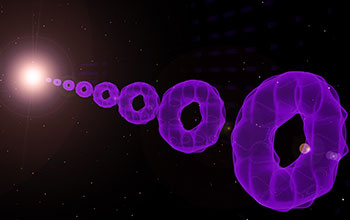Multimedia Gallery
Expanding ring-shaped cloud of atoms
An expanding, ring-shaped cloud of atoms shares several striking features with the early universe.
More about this image
Researchers playing with a cloud of ultracold atoms uncovered behavior that bears a striking resemblance to the universe in microcosm. Their work forges new connections between atomic physics and the sudden expansion of the early universe.
"From the atomic physics perspective, the experiment is beautifully described by existing theory," says Stephen Eckel, an atomic physicist at the National Institute of Standards and Technology and lead author of a published paper on the research. "But even more striking is how that theory connects with cosmology."
In several sets of experiments, Eckel and colleagues rapidly expanded the size of a doughnut-shaped cloud of atoms, taking snapshots during the process. The growth happens so fast that the cloud is left humming, and a related hum may have appeared on cosmic scales during the rapid expansion of the early universe -- an epoch that cosmologists refer to as the period of inflation.
The work brought together experts in atomic physics and gravity, and the authors say it is a testament to the versatility of the Bose-Einstein condensate (BEC) -- an ultracold cloud of atoms that can be described as a single quantum object -- as a platform for testing ideas from other areas of physics.
"Maybe this will one day inform future models of cosmology," Eckel says. "Or vice versa. Maybe there will be a model of cosmology that’s difficult to solve but that you could simulate using a cold atomic gas."
To learn more about this research, see the Joint Quantum Institute news story Atoms may hum a tune from grand cosmic symphony. (Date image taken: April 2018; date originally posted to NSF Multimedia Gallery: July 20, 2018)
Credit: E. Edwards/JQI
See other images like this on your iPhone or iPad download NSF Science Zone on the Apple App Store.
Images and other media in the National Science Foundation Multimedia Gallery are available for use in print and electronic material by NSF employees, members of the media, university staff, teachers and the general public. All media in the gallery are intended for personal, educational and nonprofit/non-commercial use only.
Images credited to the National Science Foundation, a federal agency, are in the public domain. The images were created by employees of the United States Government as part of their official duties or prepared by contractors as "works for hire" for NSF. You may freely use NSF-credited images and, at your discretion, credit NSF with a "Courtesy: National Science Foundation" notation.
Additional information about general usage can be found in Conditions.
Also Available:
Download the high-resolution JPG version of the image. (1.7 MB)
Use your mouse to right-click (Mac users may need to Ctrl-click) the link above and choose the option that will save the file or target to your computer.

